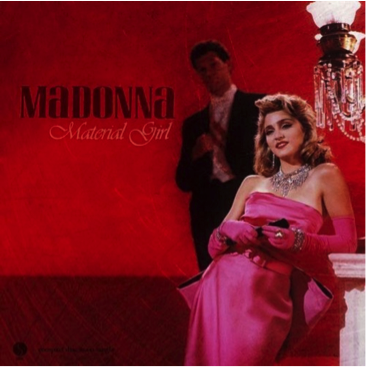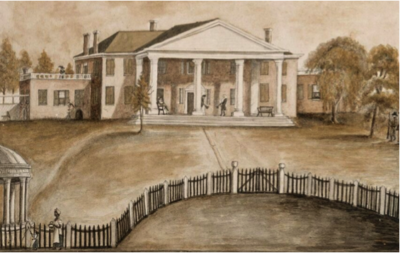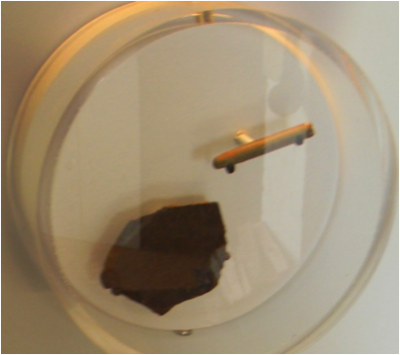Editor's Note
Today’s post is by Whitney Nell Stewart, assistant professor at University of Texas at Dallas and co-editor of Race and Nation in the Age of Emancipations (University of Georgia Press, 2018). We’re deeply grateful to her for leading our FREE Teaching Intellectual History workshop, “Beyond the Text: Reading Objects and Images” on Saturday, 27 March 2021, 12pm-3pm EST. Read on for all the details, and register here.

Madonna professed herself a material girl in the 1985 song of the same name. Madonna, “Material Girl” (1985), IMDb, https://m.imdb.com/title/tt6612364/mediaviewer/rm2194419712/.
I don’t consider myself to be an intellectual historian. Probably some of you reading this would not identify yourselves as such, either. That’s in part because I (and maybe you) have long held a very narrow definition of what, exactly, intellectual history is. But when you browse through the USIH blog or recent USIH Conference programs, it becomes very clear that the field is in fact capacious, that intellectual history can incorporate far more source materials, topics, and methodologies than you might first assume. Yet intellectual historians, like the majority of those in the broader history discipline, continue to rely almost exclusively on texts for their evidence, on subjects that seem to be clearly about “big ideas,” on reading sources as we learned to in graduate school History programs.
I and my fellow Teaching Material & Visual Culture Workshop leaders are here to make you think twice before using that same stale newspaper article or diary entry in your classroom. It’s time to incorporate objects and images more directly into our work, including our teaching, of US history. And we want to help give you the knowledge and confidence to do so.
Why include artifacts, for instance, when we can so easily pull a transcribed letter from a documentary primary source collection? I’ll let the pop-star goddess Madonna answer that one: because “we are living in a material world, and I am a material girl.” The complex meaning behind this seemingly straightforward statement in fact parallels the fundamental tenets of material culture: the insistence that objects are prevalent and essential to contemporary and past societies; the recognition that humans are an active part of this material world; and the understanding that culture expresses itself through material objects.

How, for instance, do students analyze and interpret this 1818 watercolor painting of the Montpelier mansion? Does the meaning change when put in conversation with the slate and pencil found beneath a slave cabin adjacent to the mansion? Baroness Anne-Marguerite-Henriette Hyde de Neuville, Montpellier, 1818, watercolor. Musée Franco-Américain du Château de Blérancourt, https://www.pop.culture.gouv.fr/notice/joconde/000DE025571.
Objects, as evidence, are not just solid, static, material entities; artifacts are expressive and creative. One of the earliest uses of the term “material culture” recognized the reflective nature of objects, which display “outward signs and symbols of particular ideas in the mind.”[i] Material culture evidence reveals micro and macro beliefs and values; the artifact’s construction and use is constrained by, and ultimately reflects, social rules. Objects are not just created by men in circumstances not of their own making, however, but are participatory in the formulation of those circumstances. Things, notes Dell Upton, “are part of the symbolic process that continually recreates the world by imposing meaning and order on it.”[ii] Material culture (like visual culture) is reactive and active, providing tangible (or visual) examples of culture while simultaneously acting in that culture’s creation and propagation.
But how do you do it? Despite the argument that you can “read” anything, analyzing and interpreting objects and images is not the same as doing so with a text. How scholars of material and visual culture get to that goal of better understanding people and culture differs greatly. This is one reason I wanted to bring together a wide array of practitioners to help create a Guide for Analyzing Material and Visual Culture Sources. This is not a definitive rule book for doing material and visual culture analysis, but rather a general blueprint for walking students through the process of better “reading” objects and images. In particular, we want students thinking about the multiple layers evidenced in these pieces of evidence. Although historian of technology Brooke Hindle has called for material culturists to “see through the objects to the historical meaning to which they relate,” we cannot think of an object as transparent.[iii] Objects have many layers of meaning; we must seek to peel back each of those layers. Students are far better equipped to do this than you might assume. As we all know, students are curators of their own lives. Constantly inundated with visuals and consumer products, they know how to organize and value pictures and things. But that doesn’t mean they’re prepared to describe, deduce, speculate, contextualize, research, and argue about them.[iv] Our goal with this guide is to prepare you and them to peel back the layers of meaning, helping them not only better understand the past but also better interrogate the objects and images in their present.

Slate and pencil found beneath South Yard cabin during archaeological excavations. Currently on display in South Yard cabin, James Madison’s Montpelier. Photo by the author, June 2018.
In the next couple months, the workshop leaders (listed below) will together create such a guide for you to use with your students, relevant for any History course at the advanced high school or college level. At the USIH Conference Workshop in March, each workshop leader will present a single image or artifact that they think more US history teachers should bring into the classroom. They will talk us through why they love it, why it is such a great source to use, and how they go about introducing it to and examining it with students. Then, we will present our Guide for Analyzing Material and Visual Culture Sources and open to questions from the audience. We hope to have a lively discussion about pedagogy, methodology, sources, and much more. After the workshop concludes, we will post the Guide and links to all the sources we discussed here on the USIH blog.
Hope to see you all at the workshop!
Workshop leaders:
Elizabeth Chew, Executive Vice President and Chief Curator, James Madison’s Montpelier
Michelle Everidge, Director of Strategic Initiatives, Witte Museum
Aston Gonzalez, Associate Professor of History, Salisbury University
Jennifer Hammond, Director of Education & Bradley C. Brooks, Curator, Bayou Bend
Collection at the Museum of Fine Arts, Houston
Elizabeth Humphrey, Curatorial Assistant and Manager of Student Programs, Bowdoin College Museum of Art
Jonathan M. Square, faculty member in the Committee on Degrees in History and Literature, Harvard University
Whitney Stewart, Assistant Professor of History, University of Texas at Dallas
Jennifer Van Horn, Associate Professor of Art History, University of Delaware
[i] A. Lane-Fox Pitt-Rivers, “On the Evolution of Culture,” in The Evolution of Culture and Other Essays, ed. J. L. Myers (Oxford: Clarendon Press, 1906), 23.
[ii] Dell Upton, “Material Culture Studies, A Symposium,” Material Culture 17, no. 2/3 (Summer-Fall 1985): 85.
[iii] Brooke Hindle, “Technology through the 3-D Time Warp,” Technology and Culture 24:3 (July 1983): 464.
[iv] This is generally the method laid out in the seminal material culture article by Jules David Prown, “Mind in Matter: An Introduction to Material Culture Theory and Method,” Winterthur Portfolio 17, no. 1 (Spring 1982): 1–19.

0